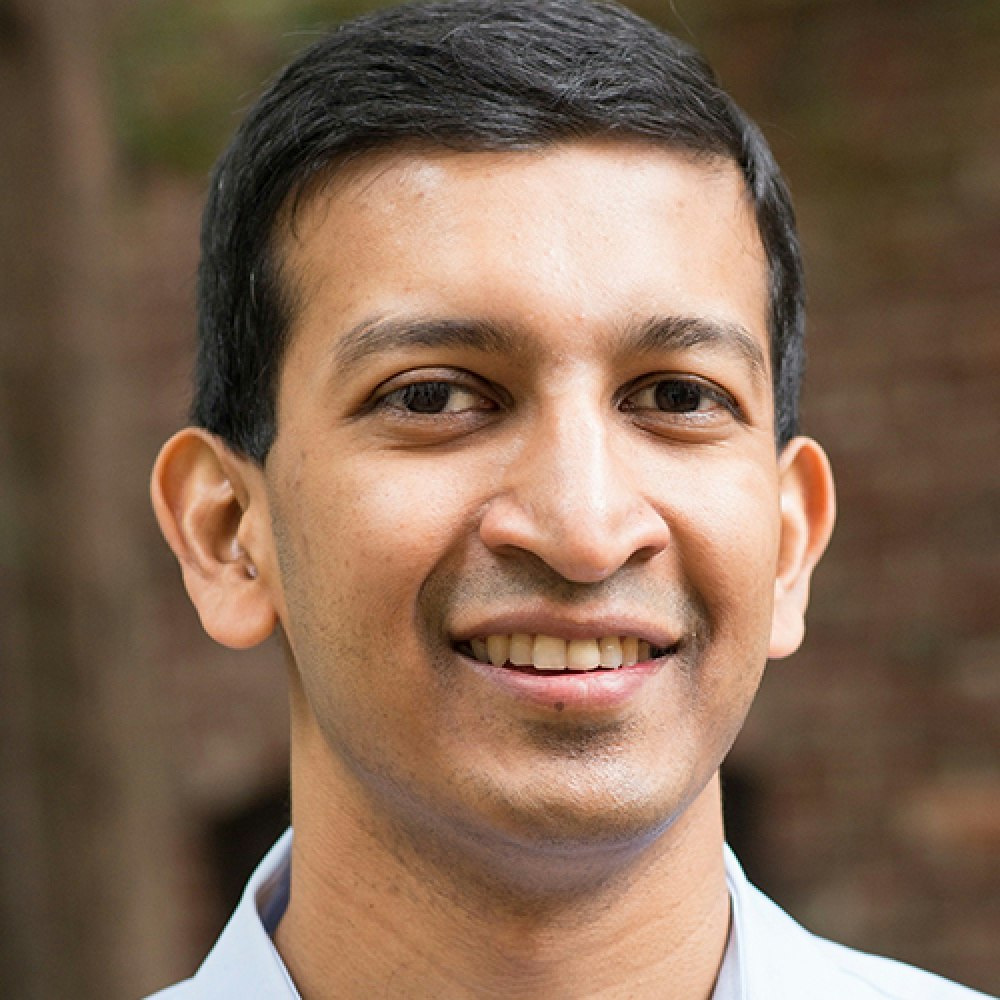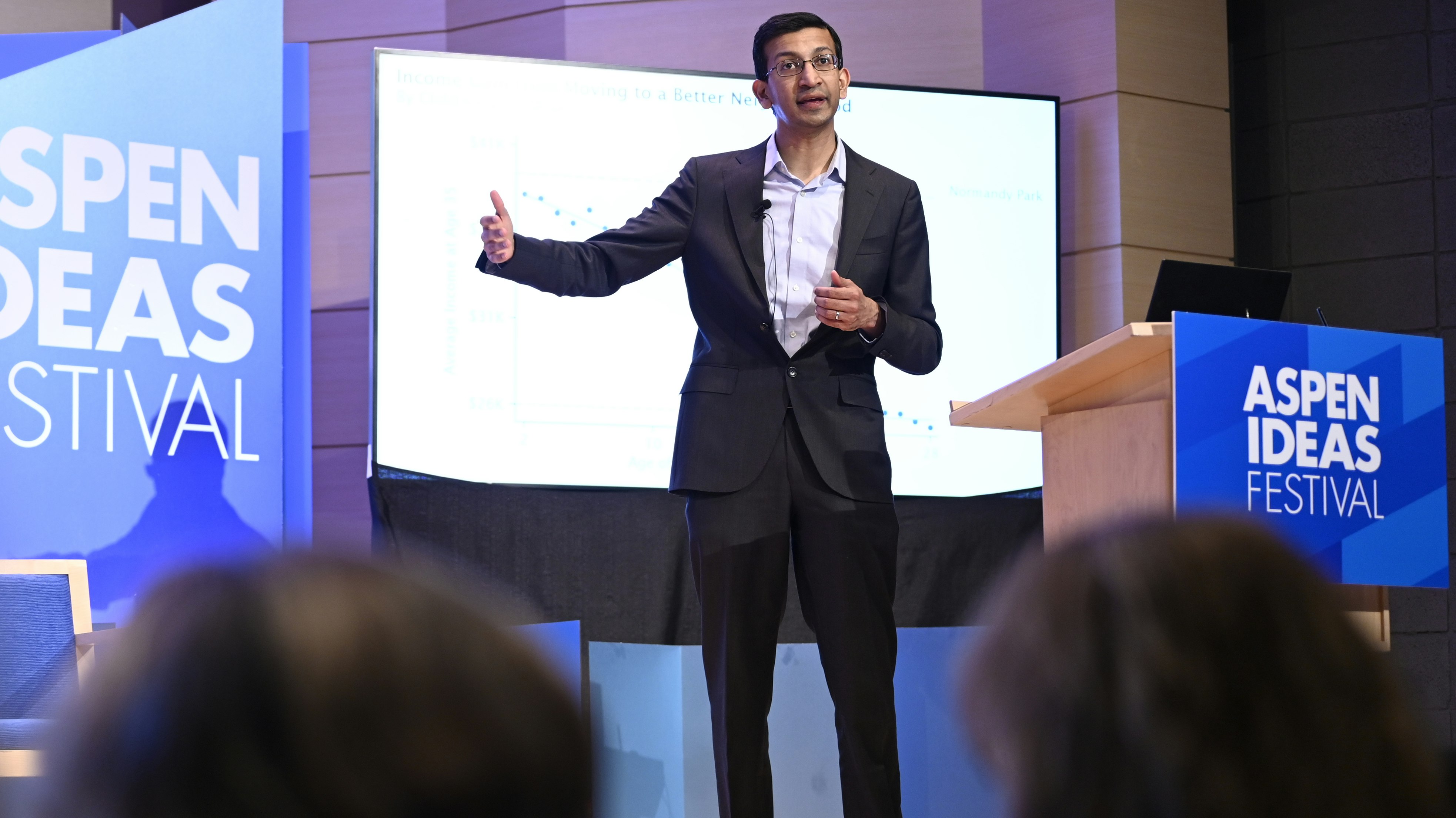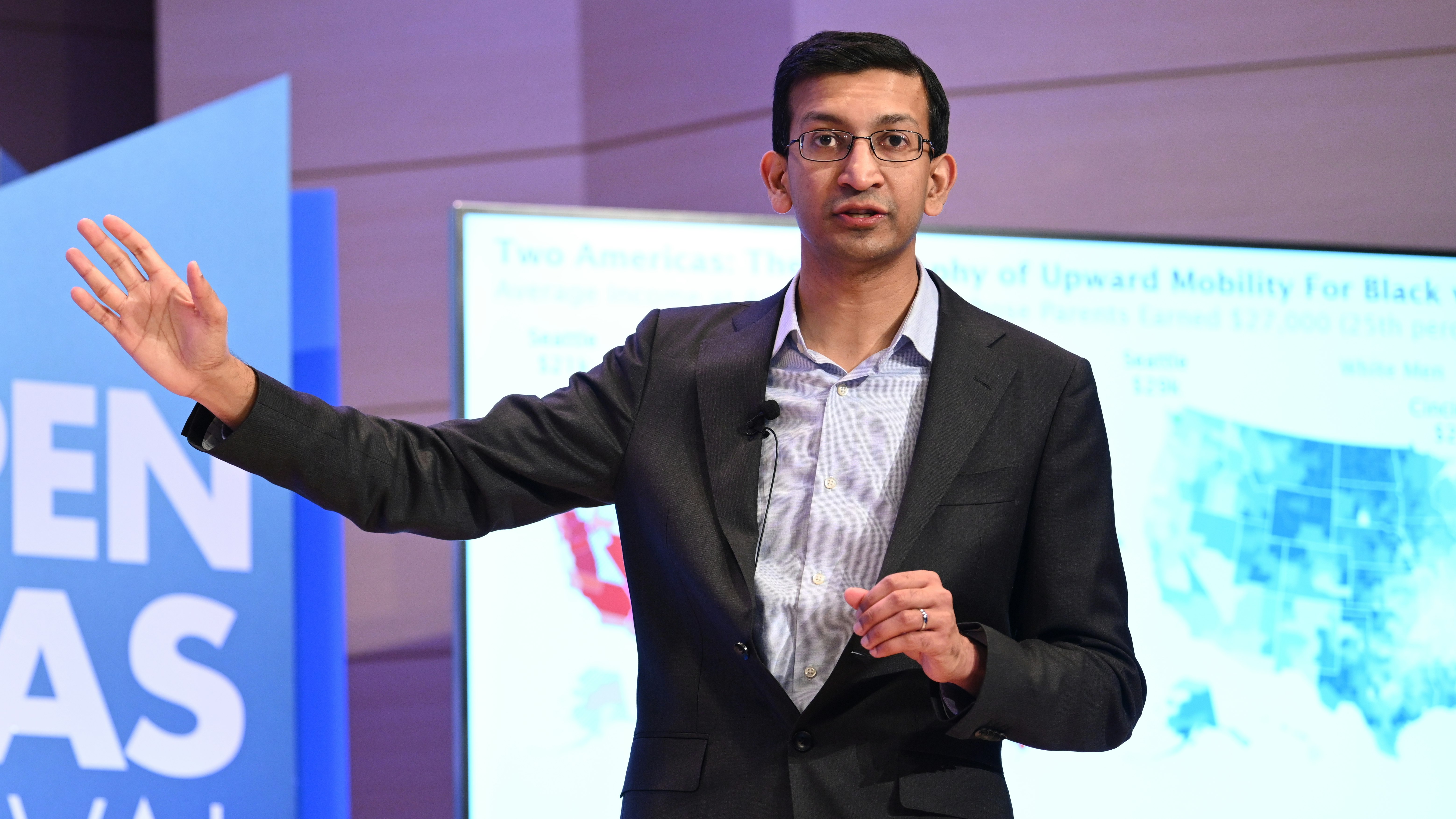

Geography of Opportunity

It’s essentially a 50-50 shot as to whether you’re going to do better than your parents.
Setup
How do we develop scalable policy solutions that will empower families throughout the United States to rise out of poverty and achieve better life outcomes? How we can improve children’s opportunities in communities that currently offer limited prospects for upward income mobility? Award-winning Harvard scholar Raj Chetty, whose research focuses on equality of opportunity, shares remarkable, data-driven insights that can inform policy solutions at every level — and region — of society.
- 2019 Festival
- Economy
- Society
- USA
- Full transcript
Is the American dream alive and well?
The American dream means a lot of things, says economist Raj Chetty, but broadly speaking it signifies equal opportunity for socioeconomic advancement. Chetty was curious if this promise of generational growth holds water, so he looked at the numbers:
Someone born in the 1940s had over a 90 percent chance of earning more than their parents, says Chetty. But that number has plummeted, and today “it’s essentially a 50-50 shot as to whether you’re going to do better than your parents.” Chetty goes on to say that even those 50 percent odds aren’t the whole picture. Some places are doing better than others, and there are clear geographic indicators that determine if the American dream is alive in your neighborhood.
Economic mobility is way more localized than you’d think
When Raj Chetty displays maps of economic mobility around the country, it’s easy to think that whole states or cities are more or less upwardly mobile. Chetty says that isn’t so, and he uses an example from New York City to prove his point:
By zooming into a block-by-block map of economic mobility, Chetty shows that a city like Manhattan, which as a whole seems upwardly economic mobile, can have neighborhoods just a few blocks apart that are on opposite ends of the economic mobility spectrum. Chetty says this phenomenon shows up almost everywhere around the country, and that generalizing whole cities and states as more or less upwardly mobile erases important details.
See for yourself
The later you move, the worse your outcomes
Raj Chetty tracked young people as they moved from areas of less opportunity to areas of greater opportunity in the Seattle metro in order to better understand geography’s relationship to economic mobility. He discovered three critical takeaways:
This excerpt has been lightly edited for clarity
-

Raj Chetty: The first is that where you grow up really seems to matter… If you take a given child and help that child move to a higher opportunity area where we're seeing better outcomes for kids who grew up there from birth, that child ends up doing much better, has significantly better life outcomes, not just in terms of earnings, but a variety of other outcomes like college attendance rates, lower rates of incarceration, and so forth. Second, what really seems to matter is childhood environment rather than where you're living as an adult. We see in this study and in other analyses we've done that helping people move to a different area after they're 23 or so has essentially no impact on their economic outcomes. Third, you see that every extra year of childhood exposure to a better environment leads to better outcomes. So there's kind of a dosage response here. If you spend two years in a better area that yields some benefit. If you spend four years or six years in a better area, you get a cumulatively larger impact.
Chetty says that these findings should have major implications for policy makers as they try to allocate funds and resources to have the greatest impact.
What makes some areas better than others?
The evidence is plain that geography plays a huge role in economic mobility, says Raj Chetty. The question is, why? Chetty points to four main reasons:
Although these aren’t hard and fast rules, Chetty says that lower poverty rates, more stable family structures, greater social capital, and better school quality are all strongly predictive of economic mobility within any given neighborhood.
From research to policy: three pillars
If researchers understand the root causes of unequal economic mobility, says Chetty, they can give concrete advice to policy makers. Chetty has put together a plan to level the playing field of economic mobility, centered around three main pillars:
Take Action
- Reduce segregation
- Place-based investments
- Improve higher education
Reducing economic segregation (helping families move to more advantaged neighborhoods) is a comparatively straightforward solution, says Chetty, but not scalable enough to address the whole problem. To improve communities themselves, Chetty advocates for targeted, place-based investments that stay in communities. And lastly, higher education becomes a critical component of economic mobility that’s both neglected and underutilized.
Learn More
Additional Information
Explore More
Economy


While the workforce continues to evolve in response to economic shifts and technological advancements, one thing is certain — the traditional blueprints for education and the...


Living as a trans person in America comes with its share of challenges, which are sometimes even life-threatening. But some say it can also open up access to incredible freedo...

Entrepreneurs view the world differently. Where others see challenges, they see opportunities. They’re a group of self-starters and strivers with the courage to take big risks...

Global conflicts and health crises have put into stark relief deeply-ingrained gender roles in society. Yet the past years have also seen record-high numbers of women running...


Creativity is as intrinsic to our species as any of our basic instincts, says Debbie Millman, designer and curator. But for millions of people in the United States, the abilit...

The people in our lives shape who we are. But great relationships don’t just happen — they take care, intention, and ongoing effort. How do you know when to let go, adjust exp...


Advances in medicine and healthy living mean that more and more people will live to be 100. But just because their bodies can last doesn’t mean their bank accounts will keep u...


In the early days of cable television, there wasn’t a single network aimed at Black audiences. Sheila Johnson and her husband at the time saw an opening, and put all their hop...

Of course, Black history shouldn’t just be a month-long nod on our yearly calendar — it is inextricable from American history and fundamental to the very soul of our nation an...


Owning a professional sports team is not for the faint of heart. Results are volatile and wins and losses come with the strong emotions of a city’s fan base. But it’s a sound...


Looking around and experiencing the suffering and injustice in the world can make it difficult to believe that happiness exists. But the Judeo-Christian tradition teaches that...


This episode is from the 2022 Aspen Ideas Festival, but we’re bringing it back because it’s still as relevant as ever. Though it can sometimes feel like conflict and discord i...


Sir Ken Robinson believed that as a society, we tragically underestimate and underutilize human ability. We create linear systems for our minds modeled on industry and manufac...


Young people in America are struggling. The causes are varied and may not be entirely clear, but the results are unfortunately unmistakable. Many of our youth feel lonely, iso...


Many more Americans are struggling to survive and make ends meet than is typically portrayed in the media and public policy debates. And when poverty is depicted, harmful and...

New York Times columnist and bestselling author David Brooks is known for bringing his thoughtful reflections on politics and culture, but at this year’s Aspen Ideas Festival,...

Jump in by watching our 15 most popular talks of all time. From black holes to jazz and civil rights to psychology hacks, we've collected the talks that remain audience favori...


America’s “second founding” came on the heels of the Civil War, when the architects of the 13th, 14th and 15th amendments thought long and hard about how to enshrine civil rig...

Finding the national and global headlines understandably bleak lately? Whether you need mental distraction or stimulation, engross yourself in compelling topics and get a gli...

The United States spends $4.3 trillion—almost one fifth of the nation’s GDP—on health care. As the scale of the medical enterprise expands, venture capitalists are pursuing th...














